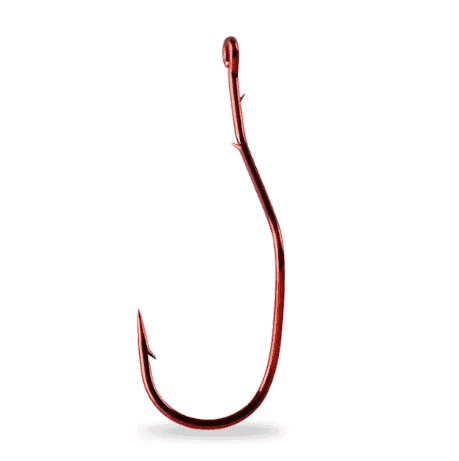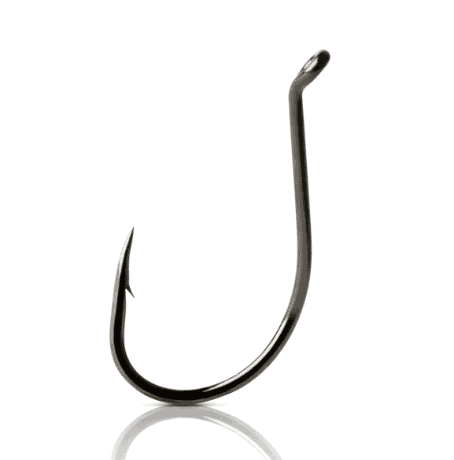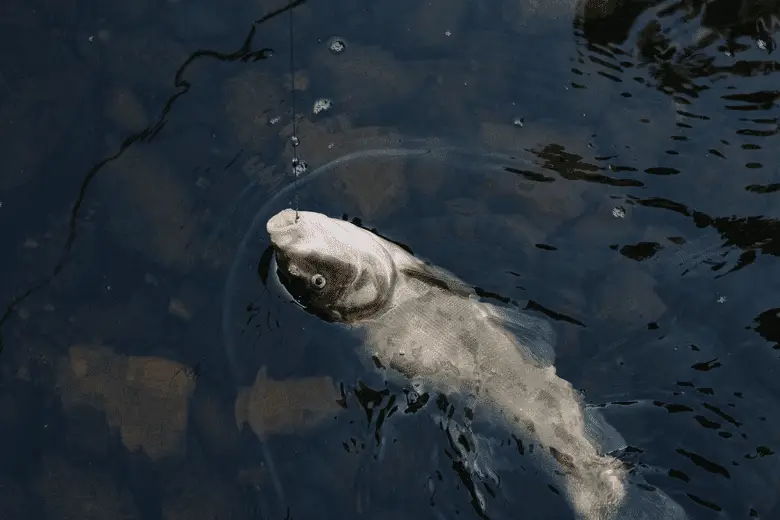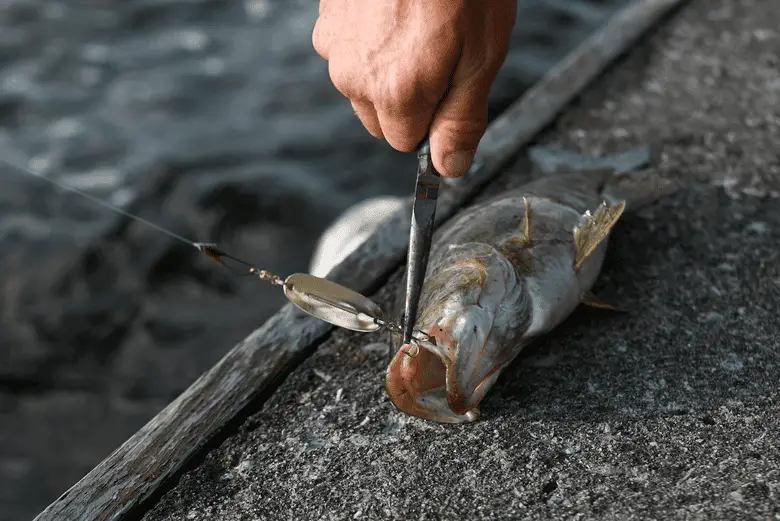In the case of largemouth bass, the fish’s name hints at what hook size to use. Yes, they have big mouths. But does this mean you should always rig big hooks?
You’ll see largemouth hunters using a variety of sizes. By and large, they fall between 1/0 and 6/0.
Largemouth have very big mouths. And if you’ve seen trophy fish over 8 pounds, you’ll swear a massive shark hook would barely touch the sides.
So, given 1/0 to 6/0 covers the extremes, could we hedge our bets with a 3/0, confident we’re in with a chance whatever fish size we catch?
Maybe.
However, it’s a bit more nuanced than that. We must consider several factors to ensure we have the correct hook size for largemouth bass.
Let’s check it out in more detail.
Page Contents
Hook Sizing
The chart below, courtesy of Mustad Fishing, illustrates fishing’s hook sizing system.
| Hook Size | Hook Gap | Length | Length |
|---|---|---|---|
| 1 | 9.12 | 0.685in | 17.4mm |
| 1 | 9.12 | 0.685in | 17.4mm |
| 1/0 | 10.02 | 0.748in | 19mm |
| 1/0 | 10.02 | 0.748in | 19mm |
| 1/0 | 10.02 | 0.748in | 19mm |
| 10/0 | 23.82 | 1.787in | 45.4mm |
| 10/0 | 23.82 | 1.787in | 45.4mm |
| 2 | 8.46 | 0.634in | 16.1mm |
| 2 | 8.46 | 0.634in | 16.1mm |
| 2/0 | 10.86 | 0.815in | 20.7mm |
| 2/0 | 10.86 | 0.815in | 20.7mm |
| 2/0 | 10.86 | 0.815in | 20.7mm |
| 3/0 | 12 | 0.898in | 22.8mm |
| 3/0 | 12 | 0.898in | 22.8mm |
| 3/0 | 12 | 0.898in | 22.8mm |
| 3/0 | 12 | 0.898in | 22.8mm |
| 4 | 7.26 | 0.543in | 13.8mm |
| 4 | 7.26 | 0.543in | 13.8mm |
| 4/0 | 13.14 | 0.984in | 25mm |
| 4/0 | 13.14 | 0.984in | 25mm |
| 4/0 | 13.14 | 0.984in | 25mm |
| 4/0 | 13.14 | 0.984in | 25mm |
| 4/0 | 13.14 | 0.984in | 25mm |
| 5/0 | 14.22 | 1.067in | 27.1mm |
| 5/0 | 14.22 | 1.067in | 27.1mm |
| 5/0 | 14.22 | 1.067in | 27.1mm |
| 5/0 | 14.22 | 1.067in | 27.1mm |
| 5/0 | 14.22 | 1.067in | 27.1mm |
| 6 | 6.3 | 0.472in | 12mm |
| 6/0 | 15.6 | 1.169in | 29.7mm |
| 6/0 | 15.6 | 1.169in | 29.7mm |
| 6/0 | 15.6 | 1.169in | 29.7mm |
| 6/0 | 15.6 | 1.169in | 29.7mm |
| 7/0 | 17.22 | 1.291in | 32.8mm |
| 7/0 | 17.22 | 1.291in | 32.8mm |
| 7/0 | 17.22 | 1.291in | 32.8mm |
| 8/0 | 19.14 | 1.433in | 36.4mm |
| 8/0 | 19.14 | 1.433in | 36.4mm |
| 8/0 | 19.14 | 1.433in | 36.4mm |
| 9/0 | 21.42 | 1.606in | 40.8mm |
| 9/0 | 21.42 | 1.606in | 40.8mm |
| 9/0 | 21.42 | 1.606in | 40.8mm |
Numbers 1/0 through to 8/0 show a logical progression – the bigger the number, the bigger the hook.
You’ll note the smaller hook sizes indicated by single numbers. For these, it is the converse – the bigger the number, the smaller the hook – yep…go figure.
This system is employed industry-wide. However, there is no specific industry standard in terms of hook dimensions.
For example, a 1/0 hook manufactured by Mustad will likely have different dimensions to a 1/0 hook of the same style that’s manufactured by Gamakatsu.
While they’ll be similar and may even share one or two key dimensions, they’re unlikely to be the same.
And this is the case across the industry.
Another factor complicating hook size is hook style or shape. There are many types of hooks with specific design features.
You’ll be aware of long shank, short shank, circle, J hooks, octopus, and an endless list of others.
Many hooks have proprietary names unique to a particular manufacturer.
Here is a Slow Death Aberdeen hook (left). It’s a Mustad proprietary hook designed for baiting up earthworms and nightcrawlers.
On the right is a Mustad Octopus hook. It’s a strong hook ideal for a wide variety of bait types and fish targets.


If that’s not enough, we also have another variable in the thickness of a hook or the gauge of wire.
Gauge or thickness is all about strength and rigidity. You’ll see hooks 2X strong, for example. These hooks are for big fish.
Thin gauge hooks are common for smaller fish such as trout. They’re commonly shaped for use with soft plastics.
Also Read: What is The Right Hook Size For Trout
So, having taken all of this hook size nuance on board, you’ll realize that hedging your bets on a 3/0, while not the worst tactic, doesn’t maximize your chances across all techniques and applications.
So, how do you select the best hook for bass fishing?
How To Choose the Right Hook Size For Largemouth Bass
There are several factors to consider when selecting the right hook size. Getting it right can make the difference between a productive day and a slow day.
Location
Where am I fishing? Am I fishing in a suburban pond? Remote river? Am I land-based or floating?
Geography/Conditions
Am I fishing in a rocky location? Or are there lots of weed beds? Is there heavy and hard cover such as trees, logs, piers, etc? Am I fishing deep or shallow?
Is there a heavy current, or is the water still or slow moving? Is this a heavily fishing location such as an easily accessed marina? Or am I out in the wilderness off the beaten track?
Target Fish Size
Often we’ll know what a particular location holds regarding largemouth sizes. Sometimes it’s more of a mystery.
Am I chasing trophy fish specifically? Is it a case of expecting anything – small to monster? Or is it a location or time of year commonly producing smaller fish?
Bait Type
Am I casting lures, using live baits, whole dead baits, or cut flesh baits? With soft plastics, a wide variety of hook selections are available depending on the lure profile.
With soft plastics, hook size, and shape are more complicated and must be considered relative to your rod and technique.
For hard body lures, the trebles supplied are appropriately sized based on the lure action, weight, and size. You can change to different sizes, but this is best avoided and unnecessary.
The hook needs to hold the bait securely without dominating the bait or being lost in the bait. More often than not, your bait type and size will determine a hook size.
Remember that dead and cut baits will often require a larger hook than live bait.

Nightcrawlers/Earthworms
These slimy morsels are great bass bait. Even small amounts can be responsible for monster bass. However, if you want big bass, get big worms – bass love them.
The size of the worm makes it pretty easy to select a hook. 1/0 is pretty common, and I will even go smaller if I have smaller worms.
There are several ways to bait up with nightcrawlers and worms. Single penetration around the head is popular. It allows plenty of movement and keeps the worm moving longer.
You have quite a bit of scope with hook size here. This is also true when you loop it through twice near the head. Use a 1/0 or even a 2/0.
I like to thread a worm up the length of a hook with a longer shank, such as a J hook. It holds better for multiple casts into cover. Again, 1/0 or 2/0 are most suitable.
Craws
Craws are a little trickier to bait up and take various hook sizes.
Big craws are fantastic for massive largemouth bass. Along with big shad and minnows, craws are a must-try for those hunting trophy bass.
I’ll like to return any big fish I catch to the water as healthy as possible, so I prefer circle hooks or octopus hooks, even though they might not be perfect.
More often than not, I’ll be using 4/0 to 6/0. I want enough hook exposed to ensure good penetration.
Generally speaking, I’m chasing trophies when using big craws, so I’m not too concerned if I’m precluding interest from a smaller class of fish.
Shad and Minnows. Live baits
More often than not, I’m hooking these guys through the nose or lip. Sometimes I’ll hook in the back above the lateral line.
Whatever the case, hook size is determined by the bait size. With particularly small baits, size 1 and 2 J-style hooks – something with a longer shank, are good.
You’d think bigger baits, such as a big shad, require anything from a 4/0 to 6/0. In some cases, these hook sizes might be appropriate, even necessary.
However, a 2/0 through the nose, standard gauge, works wonders and keeps your live bait swimming longer.
Key Strategy Confirmed
Having answered these key questions, we can decide on a strategy and technique most likely to succeed. This will determine a rig and a hook size.
Here are some options and techniques to match hook sizes. But firstly, here’s a pretty critical hint.
Smaller Hooks Are Often Better
In all but the rarest circumstances, it’s wise to use the smallest hook you can get away with. Don’t go too small, however. Too small is equally bad.
For example. I’m using a small/medium-sized live craw. A 5/0 wouldn’t be out of place here, but I’ll use the 3/0 if it holds the bait securely.
Here are 7 reasons I’ll go smaller over bigger, but avoid too small.
- Big hooks stand out in natural bait. They look unnatural and can spook your target fish.
- Big hooks can be heavy and inhibit the natural action of a lure, making the bait unattractive to fish.
- The Bigger the hook, the more problems you face when fishing heavy cover. Big hooks are a magnet for snags.
- Big thick hooks have lower penetration qualities than smaller, thinner hooks. Big thick hooks aren’t ideal for lightweight finesse techniques.
- Big baits with big hooks often discourage interest from a smaller class of fish. Having said that, this may be your tactic for targeting large fish. When targeting trophies, I’ll usually use big baits and big hooks to avoid interest from smaller fish – encouraging trophy fish only.
- When using live bait, such as minnows, smaller, lighter hooks help them survive longer.
- Too small is also a problem. The hook must be large enough to hold the bait so fish do not easily remove it. The gap must be big enough to lodge in a fish’s mouth.
Which is Better – Thick or Thin?
One is not better than the other. Every hook gauge has its place. Standard gauge is generally fine with bass.
While bass are powerful and attack aggressively, thick 2X strong hooks are unnecessary.
If fishing finesse, finer hooks give you an advantage with presentation.
Many popular profiles used for chasing bass have an appropriate hook thickness for presentation while also providing great penetration.
The Different Types Of Hooks Used For Bass Fishing
Octopus Hooks
Octopus hooks are a standard and a favorite with anglers who like to tie snell knots and use live bait.
However, they’re great for various bait types, alive, dead, or cut. The snell knot is good as the eye of the hook is at the same angle as the point – ideal for hook setting.
Standard bass sizes start from 2 through to 4/0.
Circle Hooks
Circle hooks are popular with various baits, from nightcrawlers to big craws and shads.
They’re popular as fish hook themselves, usually through the side of the mouth, causing little damage, as the fish rarely swallow them. Excellent for a healthy release.
For cut and dead baits, bigger hooks are often more appropriate – anywhere from 2/0 to 5/0. Go with a thinner gauge for live bait, and match the bait size. Expect sizes from 1 through to 4/0.
Straight Shank Hooks
I love a straight shank hook, such as a J hook, and even a long shank hook for worms and nightcrawlers.
These hooks a great for baiting these creatures, particularly big worms. They’re great for retaining the bait when fishing heavy cover.
They’re also suitable for holding bait when fish are picking instead of attacking. The long shank allows for great purchase when removing a hook from a fish using pliers.

Frequently Asked Questions
Is a Size 4 Hook Good for Bass?
The size 4 hook isn’t commonly used for hunting largemouth bass. That’s not to say there isn’t a use.
A size 4 could be appropriate when hooking small live minnows through the nose, chasing a smaller class of bass.
What Size Hook Is Good for Largemouth Bass?
There is a wide range of hook sizes that work for largemouth bass. You’ll see anglers using everything from size 2 through to 6/0 and everything in between.
Go as small as possible for live baits and use a thinner gauge as practical. Cut flesh baits usually demand a larger hook.
However, whatever bait you’re casting, use as small a hook as possible without sacrificing bait security.
Although big bass are powerful and aggressive, thick 2X strong hooks are too thick and unnecessary. They would also require a powerful rod with strong action.
Do You Need a Sinker for Bass Fishing?
Plenty of common bass rigs will require a sinker such as Dropper and Carolina rigs. They’re usually necessary for getting down in the water column and for casting.
It would be a very rare set of circumstances that would see me using a sinker with a live bait rig. For me, live baits sit on a hook tied to my mainline.
As a rule of thumb, use only as much weight as you need. Just like hooks, use the smallest sinker you can get away with.
Sharing is caring!
